Trouble in Tahiti
TROUBLE IN TAHITI
Scenic and Costume Designer: Martin T. Lopez; Lighting Designer: Josh Epstein
Lawrence Edelson, Director and Choreographer
Opera Santa Barbara - 2011


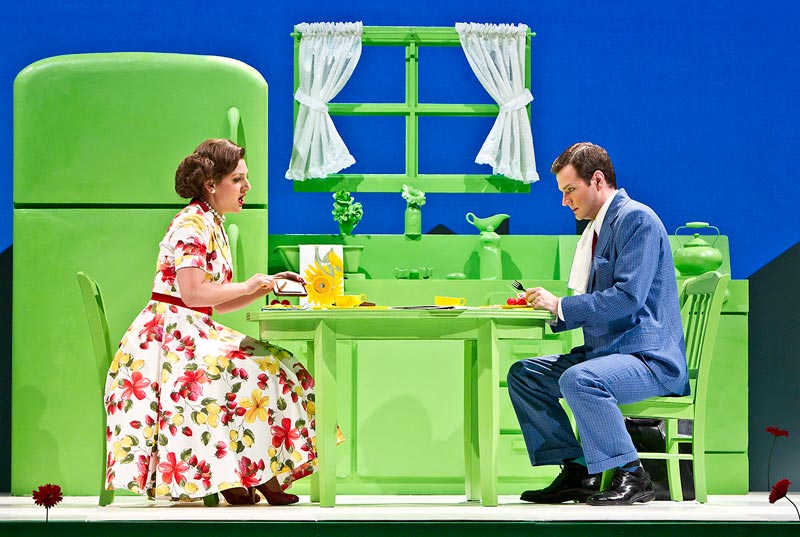


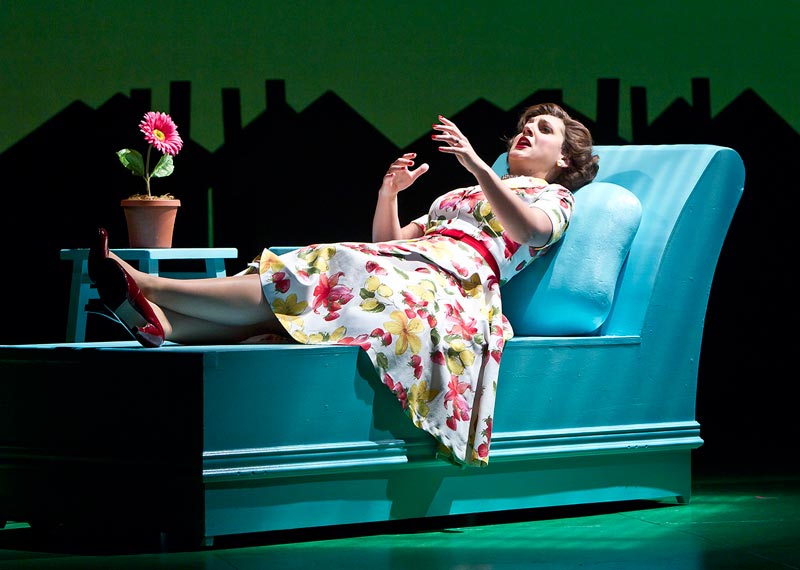
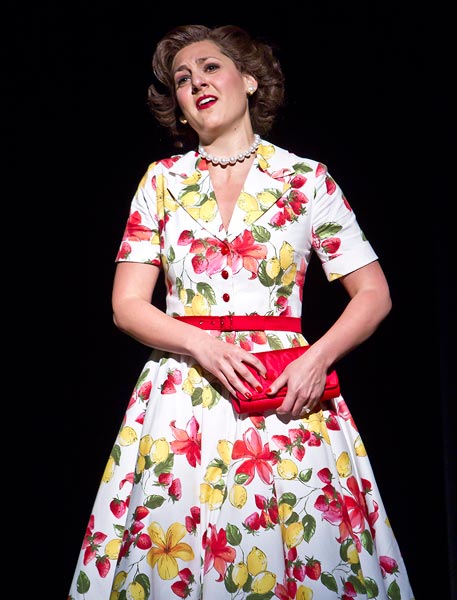



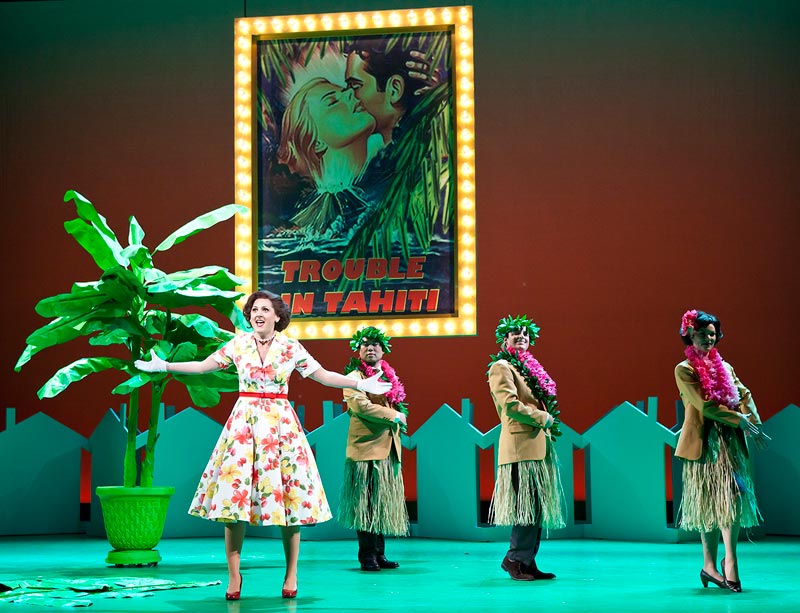



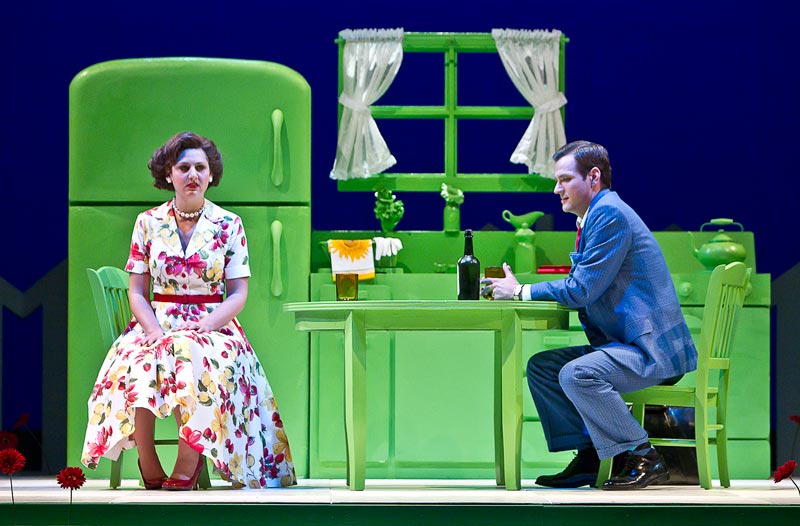

“
”Love and marriage, as one musical theater composer noted, go together like a horse and carriage. While the idea of getting hitched can be exhilarating, the actual journey is often bumpy. Opera Santa Barbara presented both sides of this coin last weekend in the Lobero Theatre... Giovanni Pergolesi’s La serva padrona, which dates from 1733, is a bubbly comedy about a maid who schemes to get her bachelor employer to propose to her. Leonard Bernstein’s Trouble in Tahiti, which premiered in 1952, shows us a day in the life of an unhappy marriage. While both scores are marvelously inventive... they make for an unlikely pairing. But this particular arranged marriage worked splendidly, thanks to the stylish and energetic conducting of Mark Morash, the enormous talent of six young professional singers (all resident artists at the San Francisco Opera’s renowned Adler Fellowship Program), and the cleverness of stage director Lawrence Edelson and set and costume designer Martin T. Lopez. Edelson moved the baroque opera ahead in time two-plus centuries, so that it, too, was set in the 1950s; the lord of the manor became a Hugh Hefner-like figure in blazing pink pajamas. This continuity gave the evening a genuine arc... culminating in a surprisingly powerful ending. It also allowed Lopez to create some wonderful, Technicolor-bright scenery, dominated by large silhouettes (of Playboy centerfolds in the Pergolesi, and suburban homes in the Bernstein).”
Santa Barbara Independent
”Last weekend’s double-header chamber opera event at the Lobero Theatre, gamely mixing the 18th-century wiles of Pergolesi with the 20th-century fare of Leonard Bernstein, was a wowing triumph...On this occasion, Pergolesi’s musically lustrous, satirical farce about romantic power playing, “La serva padrona,” made for a surprisingly apt playmate for Bernstein’s 1952 parody-gone-dark, “Trouble in Tahiti”... the charming and sometimes disarmingly deep two-for production made for the ideal capper in a small but mighty and well-balanced season... Mixing and matching chamber operas can be tricky business without hard and fast rules... a harmonious accord across the centuries and attitudes was at work in the Opera Santa Barbara matchup, directed and choreographed by Lawrence Edelson. At the Lobero’s opening presentation of the Pergolesi opera, the curtain rose on an eyeful of a stage set, by Martin T. Lopez, a garish bedroom setting with a giant pink bed, cutouts of chandeliers and, more audaciously, several jumbo cutouts of the comely “mudflap girl” silhouettes popular on Mack trucks everywhere. Clearly, the production took the route of ushering a Baroque work into a post-pop-art modern milieu, respecting the inherent musical beauty of the score while sprinkling late American 20th-century kitsch - including handcuffs and French maid costumes with built-in wardrobe malfunctioning - around the giddy, gaudy edges. This one-set wonder production, which worked beautifully, was the lair of the pampered, affluent playboy Uberto, who indulges his base instincts but secretly longs for his insolent maid, Serpina... [the opera] was wonderfully sung by baritone Ao Li and soprano Susannah Biller, also blessed with an attention to acting interchange, even though the nature of Baroque opera relies on repetitive dialogue.... A couple’s to-and-fro relationship is also at the troubled center of “Trouble in Tahiti”, albeit from a radically different turf, that of the early phase of post-WWII American suburbia... opening with real estate agents promising the moon in assorted suburban outposts to the stuff of darker, existential and emotional clouds. Those gold-jacketed and manically grinning real estate agents, chirpily sung by Sara Gartland, Mr. Li, and Daniel Montenegro, provided a goofy twist on the Greek Chorus, reappearing throughout the opera like nattering boosterist phonies. But the real meat...is the strained relations of a married couple, Dinah and Sam (the lucidly fine mezzo-soprano Maya Lahyani and baritone Ryan Kuster, respectively). While he exudes macho manners in the office and gym...she explore her fuzzy psyche on the analyst’s couch and in a delectably crazed scene based around a B-movie... Fifty years later, its inquiries about sanity in the suburbs, and about American complacency in general, still ring and sing true.”
Santa Barbara News Press
”Intriguing performances... La Serva Padrona opened the evening’s program. Director Lawrence Edelson conceptually set the action in a vague 1950s mis-en scene, and stylized the story of a careless playboy trapped within an artificial world...larger than life... complete with pink wallpaper, nudie figure cutouts, and leopard print chairs. The setting brought to mind a place where Hugh Hefner might encounter characters from the comic strip Blondie. Baritone Ao Li, a superb singer/actor, played the demanding bachelor, Uberto. With delightful comic timing Mr. Li captured the utter haplessness of a man whose intent on avoiding marriage is crushed by a determined maid. Delightfully sung by the enchanting soprano Susannah Biller as the scheming housemaid Serpina, this comic intermezzo was rounded out by the silently silly and doddering butler, Vespone (Daniel Montenegro). This was a rambunctious staging of a classic opera buffo. Trouble in Tahiti followed... Compelling dramatic moments were apparent in (Maya Lahyani’s) exquisite performance... full of tempo twists and surprises...Ms. Lahyani’s full-throttled approach embraced the swift changes of the rhythms and the quixotic hopes of (her) character’s marriage. Ryan Kuster, as Sam, the overtly self-assured husband, completely convinced... A trio singing radio-type jingles made up the chorus and included Sara Gartland, Ao Li, and Daniel Montenegro, all vocally spot-on and provided the necessary counterpoint for the dramatic framework. The direction from Mr. Edelson was handled with exceptional sensitivity.”
CASA Magazine”